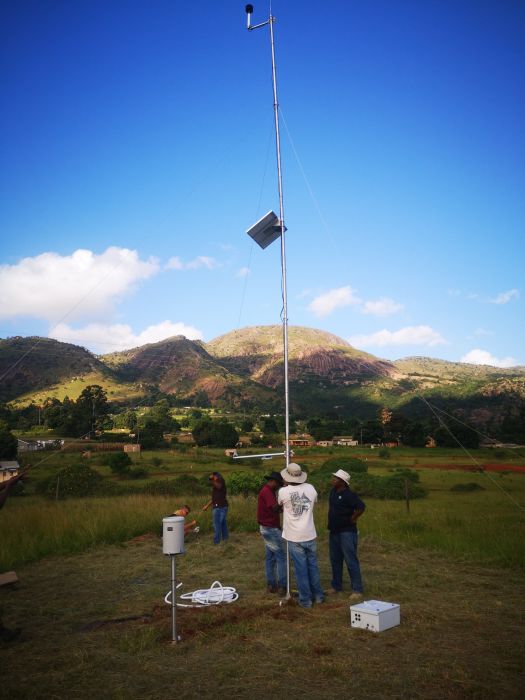




概要
南アフリカのエスワティニ王国は、農業を基盤とした経済と150万人未満の人口を抱えており、気候変動の影響を非常に受けやすい国です。この国は天水農業と天然資源に大きく依存しているため、降雨パターンの変動や干ばつや洪水などの極端な気候条件の影響を受けやすい国です。研究によると、エスワティニでは干ばつ、洪水、激しい雷、風/雹嵐、その他の異常気象など、気候関連の災害の頻度と深刻度が高まっています。これらの現象は、農業、水、観光、健康、インフラなどの重要な分野に悪影響を及ぼし、国の経済に悪影響を及ぼしています。
課題
エスワティニの国立気象サービス (MET) は、気象と気候の状況を監視し、生命と財産の安全のために勧告を出すために設立されました。しかし、既存の早期警報システム (EWS) は、気候変動のリスク、脆弱性、危険に関する包括的な知識を生み出すには不十分でした。この制限により、国は気候変動のリスクに対処するための効率的な計画、監視、緩和、適応策を実施することができません。そのため、EWS と気候サービスを改善するために、エスワティニの気象と気候の監視、データ分析、情報発信の能力を強化することが急務でした。
解決策
METでは、国連環境計画(UNEP)と国連開発計画(UNDP)の資金提供を受けて、エスワティニに20基の自動気象観測所(AWS)を設置・配備する取り組みが行われました。
エスワティニにおけるEWSと気候サービスの強化は、気候変動への適応、生命、生活、環境の保護、持続可能な開発の促進に向けた同国の取り組みに貢献することになります。
エスワティニでの AWS の導入
AWS の設置場所は慎重に選定され、UNEP 用に 10 か所、UNDP 用にさらに 10 か所が指定されました。Campbell Scientific チームは予期せぬ課題に直面しましたが、2020 年 4 月 18 日に設置を完了することができました。その後、2020 年 5 月 3 日から 7 日まで 1 週間の集中的な現地トレーニングが実施され、現地チームが AWS インフラストラクチャを効果的に維持および使用するための十分な準備が整いました。
主なシステムコンポーネント
エスワティニの AWS 設備は、正確で信頼性の高い気象データを収集するために、さまざまな最先端のコンポーネントを活用しました。主要なコンポーネントには、データロガーやさまざまなセンサーが含まれていました。
CR1000X データロガーは、センサーを測定し、データを分析し、データを安全に保存するように設計された低電力デバイスです。このデータロガーは、AWS ネットワーク全体のデータ収集と分析のための強固な基盤を提供しました。
次のようなさまざまな気象パラメータを測定するために、いくつかの高品質センサーが使用されました。
- Gill WindSonic1 と WindObserver は、風速と風向の測定に使用される超音波センサーです。革新的な設計により、メンテナンス コストが最小限に抑えられ、正確な測定が保証されます。
- HMP155A-L は、相対湿度 (RH) と温度を測定するための信頼性の高いセンサーです。正確な測定値が得られるため、幅広い用途に最適です。
- CMP10-L は、太陽放射を監視する ISO ファーストクラスの日射計です。太陽資源の可用性とパフォーマンスを評価する上で重要な役割を果たしました。
- SoilVue™10 は、土壌の水分と温度を正確に測定するように設計されたセンサーです。複数のセンサーにより、土壌の状態に関する貴重な情報が得られ、MET の担当者が環境のダイナミクスを理解するのに役立ちました。
- 降水量を正確に測定するために、複数の TB4-L 転倒マス雨量計が使用されました。これらの雨量計は、正確で信頼性の高い測定が行えるよう、慎重に設置されました。
インストール手順
インストール プロセスは、AWS インフラストラクチャの最適なパフォーマンスと寿命を確保するために、明確に定義された手順に従いました。以下は、主要な手順の概要です。
- レイアウト:各設置場所におけるセンサーの最適な配置を決定するために、包括的なレイアウト計画が考案されました。風の当たり具合、障害物、熱放射などの要素が慎重に考慮されました。
- 風速と風向:正確な風データを取得するために、Gill WindSonic1 および WindObserver センサーが環境保護庁 (EPA) のガイドラインに従って指定された高さと場所に設置されました。
- 温度と相対湿度: HMP155A-L センサーは、熱放射を避け、適切な換気を確保しながら、測定値に影響を及ぼす可能性のある障害物から離れた場所に配置されています。
- 太陽放射: CMP10-L センサーは日陰を最小限に抑えるように設置され、他の構造物からの干渉を減らすために気象観測所の最北側に配置されました。
- 土壌水分と温度: SoilVue 10 センサーの設置には、土壌特性を考慮し、周囲の土壌への影響を最小限に抑えながら、慎重な設置場所の選択が必要でした。
- 降水量: TB4-L 雨量計は、短い草または砂利が敷かれた平らな地面に設置され、水しぶきを避けて正確な降雨量を測定できるように慎重に配置されました。
メリット
これらのニーズに対応し、エスワティニのEWSと気候サービスを強化することで、このプロジェクトは国に数多くの利益をもたらしました。これには以下が含まれます。
- 強化された回復力:監視、予測、早期警報機能が向上したことにより、エスワティニは気候関連の危険に対応し、適応する態勢が強化されました。この回復力の向上により、人命の保護、インフラの保護、異常気象による経済的影響の軽減が実現します。
- 持続可能な開発:このプロジェクトは、持続可能な農業慣行、水資源管理、環境保全を支援することで、エスワティニの持続可能な開発目標と一致しています。これにより、食糧安全保障、貧困緩和、エスワティニの天然資源の保護に貢献します。
- 能力構築と知識移転:このプロジェクトには、エスワティニの気象および気候の専門家のスキルと専門知識を強化するための能力構築活動が含まれていました。この知識移転により、地元の機関は気象と気候に関する情報を独自に監視、分析、および配布できるようになりました。地元の能力を構築することで、このプロジェクトは持続可能な開発を促進し、エスワティニのEWSと気候サービスの長期的な持続可能性を確保します。
- 効果的なコミュニケーションと警報システム:共通警報プロトコル (CAP) の実装と国家警報システムおよびプロトコルの開発により、早期警報情報の普及が強化されます。CAP などの国際的に認められた標準を採用することで、プロジェクトは主要な利害関係者や一般の人々とのコミュニケーションを改善し、差し迫った災害に対する意識を高め、迅速な対応を促進します。
- 気候モデリングと予測:このプロジェクトにより、気象と気候のモデリング能力が向上し、季節予報と気候予測の作成が可能になりました。この情報は農業分野にとって極めて重要であり、農家が植え付け、収穫、水資源の管理について十分な情報に基づいた決定を下すのに役立ちます。さらに、さまざまな分野の意思決定者は、これらの予測を使用して、効果的な気候変動適応戦略を策定できます。
エスワティニでの AWS 導入の成功は、気象監視および予報機能における重要なマイルストーンです。包括的なインストールプロセスと入念なテストおよびトラブルシューティングにより、正確で信頼性の高い気象データ収集への道が開かれました。
ケーススタディの概要
アプリケーション
早期警報システムと気象サービスを改善するための気象と気候の監視場所
エスワティニ王国使用製品
WINDSONIC1-L CMP10-L HMP155A-L TB4-L SoilVue 10寄稿者
Campbell Scientific Africa参加団体
UNDP、UNEP、エスワティニ国立気象サービス(MET)計測項目
風速と風向、気温と相対湿度、太陽放射、土壌水分と気温、降水量PDFで見る